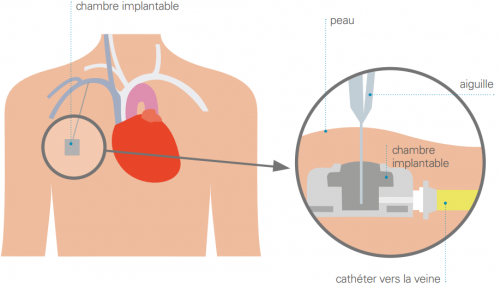Implantable devices for systemic chemotherapy
Implantable venous access devices are used for the safe delivery of chemotherapy, blood products, or long-term antibiotics.

The Division of Digestive Surgery offers specialized consultations for implantable venous access devices, whether for insertion, removal or requests related to their maintenance.
Arterio-venous fistula
An arterio-venous fistula is a communication between an artery and a vein. Such a fistula can be surgically constructed in the forearm to provide access for hemodialysis (FR) for patients with chronic renal failure. An arterio-venous fistula therefore offers an easy and high-flow access to purify the blood. This intervention is carried out by the Division of Transplantation.
Peritoneal dialysis catheter
Peritoneal dialysis (FR) is a dialysis method for patients suffering from chronic renal failure (FR) using filtration by the peritoneum - the membrane lining the abdominal cavity and abdominal organs.
In order to proceed with this dialysis technique, implantation of a catheter going through the abdominal wall into the abdominal cavity is necessary. Thereafter, dialysis fluid is infused into the abdominal cavity and absorbs the elements to be eliminated from the blood, as well as the excess water, before being sucked back through the catheter. This intervention is carried out by the Division of Transplantation.
